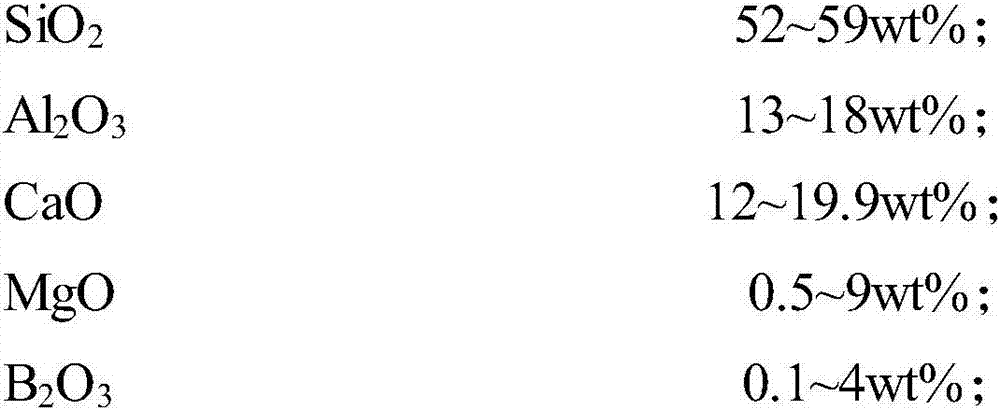Glass fiber
A glass fiber, 58wt% technology, applied in the field of inorganic non-metallic materials, can solve the problems of poor glass fiber molding performance, increased raw material cost, pollution, etc.
- Summary
- Abstract
- Description
- Claims
- Application Information
AI Technical Summary
Problems solved by technology
Method used
Image
Examples
preparation example Construction
[0031] The present invention does not have special limitation to the preparation method of described glass fiber, is preferably produced by pool kiln method, specifically can be prepared according to the following method:
[0032] Mix all kinds of raw materials evenly and put them into the tank kiln. After melting, clarification and homogenization, the glass liquid is obtained;
[0033] The glass fiber is obtained after the glass liquid is cooled, flowed out and drawn.
[0034] In the present invention, various raw materials are firstly mixed in a mixing tank, and after being uniformly mixed, they are transported to the tank kiln hopper; then the tank kiln hopper puts the mixed material into the tank kiln for melting, clarification and homogenization to obtain molten glass ; The melting temperature is preferably 1250-1450°C;
[0035] The glass liquid is cooled, flows out through the platinum bushing plate, and is drawn into a glass filament with a diameter of drawing under th...
Embodiment 1~6
[0040] Select glass raw materials according to the glass fiber composition shown in Table 1, and calculate the consumption of each raw material:
[0041] Table 1 embodiment glass fiber formula table
[0042] composition Example 1 Example 2 Example 3 Example 4 Example 5 SiO 2
52 53.2 55.4 56.6 57.8 al 2 o 3
13 14 15 16 17 B 2 o 3
4 3.2 2.4 1.6 0.5 CaO 19.5 19.8 19.4 19.8 19.9 MgO 9 7.3 5.8 4 2.2 TiO 2
0.7 0.7 0.7 0.7 0.7 Na 2 O+K 2 o
0.75 0.75 0.75 0.75 0.75 Fe 2 o 3
0.55 0.55 0.55 0.55 0.55 ZrO 2
0.5 ZnO 0.5 0.5 0.1
[0043] Then weigh the required raw materials in proportion, and transport them all to the mixing tank. After mixing evenly, transport the mixture to the tank kiln silo;
[0044] Put the mixed material in the kiln silo into the kiln. In the kiln, the mixed material is gradually melted into molten glass...
Embodiment 7
[0056] Performance tests were carried out on the above-mentioned glass fibers, and the results are shown in Table 3. Table 3 shows the formulations and properties of the glass fibers provided in the examples and comparative examples of the present invention. Among them, T logη=3 is the fiber forming temperature, which is detected by BROOKFIELD high temperature viscometer; T 液 is the upper limit of glass crystallization temperature, which is measured by Orton Model gradient furnace; ΔT is the difference between the fiber forming temperature and the upper limit of glass crystallization temperature.
[0057] The glass fiber performance data sheet that table 3 embodiment and comparative examples provide
[0058]
[0059] It can be seen from Table 3 that, compared with the comparative examples, the glass fibers provided by the examples of the present invention have better formability, the forming temperature does not exceed 1210°C, and the crystallization upper limit temperatur...
PUM
| Property | Measurement | Unit |
|---|---|---|
| diameter | aaaaa | aaaaa |
| crystallization temperature | aaaaa | aaaaa |
Abstract
Description
Claims
Application Information
 Login to View More
Login to View More - R&D
- Intellectual Property
- Life Sciences
- Materials
- Tech Scout
- Unparalleled Data Quality
- Higher Quality Content
- 60% Fewer Hallucinations
Browse by: Latest US Patents, China's latest patents, Technical Efficacy Thesaurus, Application Domain, Technology Topic, Popular Technical Reports.
© 2025 PatSnap. All rights reserved.Legal|Privacy policy|Modern Slavery Act Transparency Statement|Sitemap|About US| Contact US: help@patsnap.com



